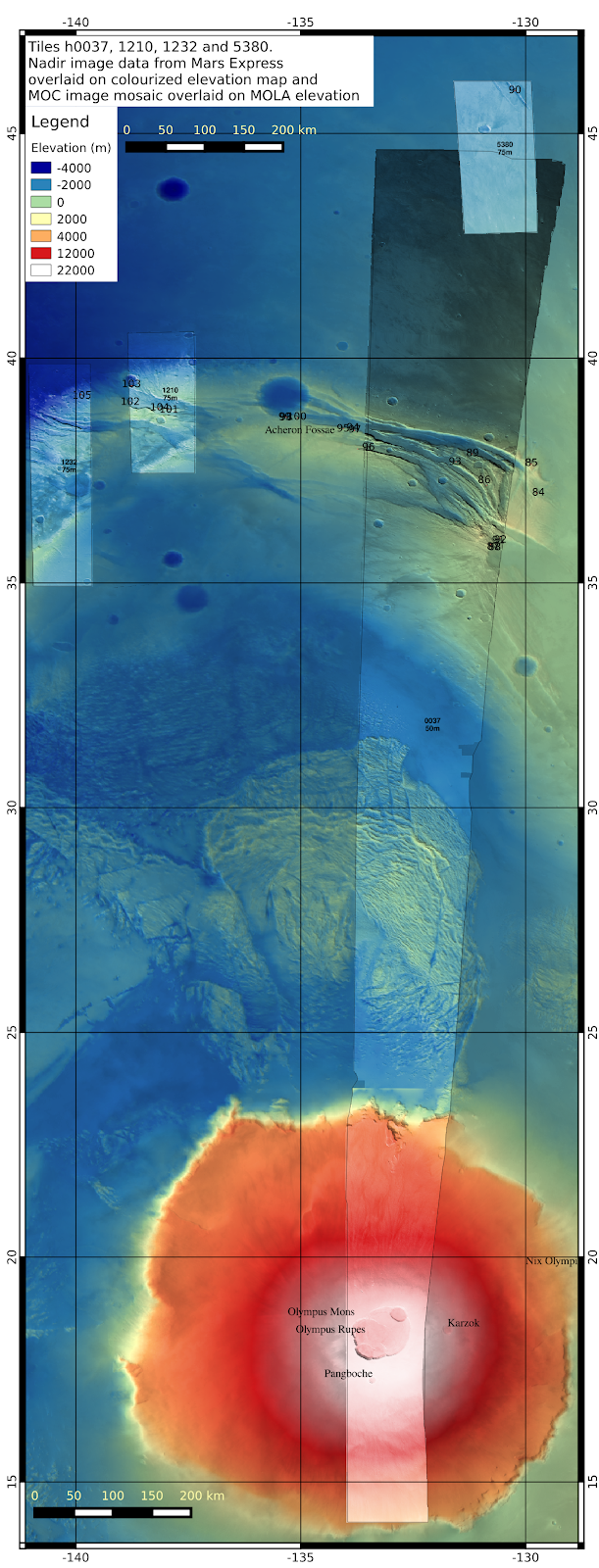The Snows of Olympus
Tags: MarsMartian glaciologyRSGISLibobject-based segmentationMars Express HRSC14 Jun 2015 - MawKernewek
The HRSC tile h0037 is a monster, it covers a vast area, the image file is 17568 x 144800 at 12.5m resolution and topography is 4391 x 36200 at 50m resolution. See also data product footprint at Mars ODE.
It covers an area including the summit of the vast Olympus Mons mountain, the largest on Mars and the largest volcano on any planet of the solar system.
There are a few Souness glacier-like forms in the north of the tile, the name 'Nix Olympia' dates back to the time of telescopic observations which perhaps mistook the brighter rocks of the Olympus Mons massif for snow.

The Snows of Olympus is also the title of a book by Arthur C. Clarke which I have, containing some speculation about colonisation and terraforming Mars, along with some computer graphics renderings which were state of the art in the early 1990s of a Mars undergoing terraforming.
The above image shows the Olympus Mons Lobate Debris Apron, which is in fact thought to be glacial in origin, at the very high obliquity epochs in Mars' past, glacial activity is believed to have occured in the tropical mountain regions around the Tharsis bulge.
The Souness glacier like forms are concentrated to the north of the tile however, and in neighbouring tiles h1210, h1232 and h5280.
The above image showed up a significant issue with the dissertation. The Bayesian classifier used the nadir image data, as well as the digital terrain model and derived topographic values. However looking at the h5280 field at 130W 45N it is clear the scaling of the image brightness is separate for each tile, which means it doesn't mean much in the context of global statistics.
In the more detailed images below, an equicylindrical coordinate system is used with a standard parallel at 40 degrees of latitude.
Showing an area around 37N, 133W, in the Acheron Fossae region.
h1210
larger version (22MB)
It covers an area including the summit of the vast Olympus Mons mountain, the largest on Mars and the largest volcano on any planet of the solar system.
There are a few Souness glacier-like forms in the north of the tile, the name 'Nix Olympia' dates back to the time of telescopic observations which perhaps mistook the brighter rocks of the Olympus Mons massif for snow.
Summary
larger version (12.7MB)
The Snows of Olympus is also the title of a book by Arthur C. Clarke which I have, containing some speculation about colonisation and terraforming Mars, along with some computer graphics renderings which were state of the art in the early 1990s of a Mars undergoing terraforming.
The above image shows the Olympus Mons Lobate Debris Apron, which is in fact thought to be glacial in origin, at the very high obliquity epochs in Mars' past, glacial activity is believed to have occured in the tropical mountain regions around the Tharsis bulge.
The Souness glacier like forms are concentrated to the north of the tile however, and in neighbouring tiles h1210, h1232 and h5280.
The above image showed up a significant issue with the dissertation. The Bayesian classifier used the nadir image data, as well as the digital terrain model and derived topographic values. However looking at the h5280 field at 130W 45N it is clear the scaling of the image brightness is separate for each tile, which means it doesn't mean much in the context of global statistics.
In the more detailed images below, an equicylindrical coordinate system is used with a standard parallel at 40 degrees of latitude.
h0037
larger version (48MB)Showing an area around 37N, 133W, in the Acheron Fossae region.
h1210 and h1232
larger version (21MB)h1210
larger version (22MB)



